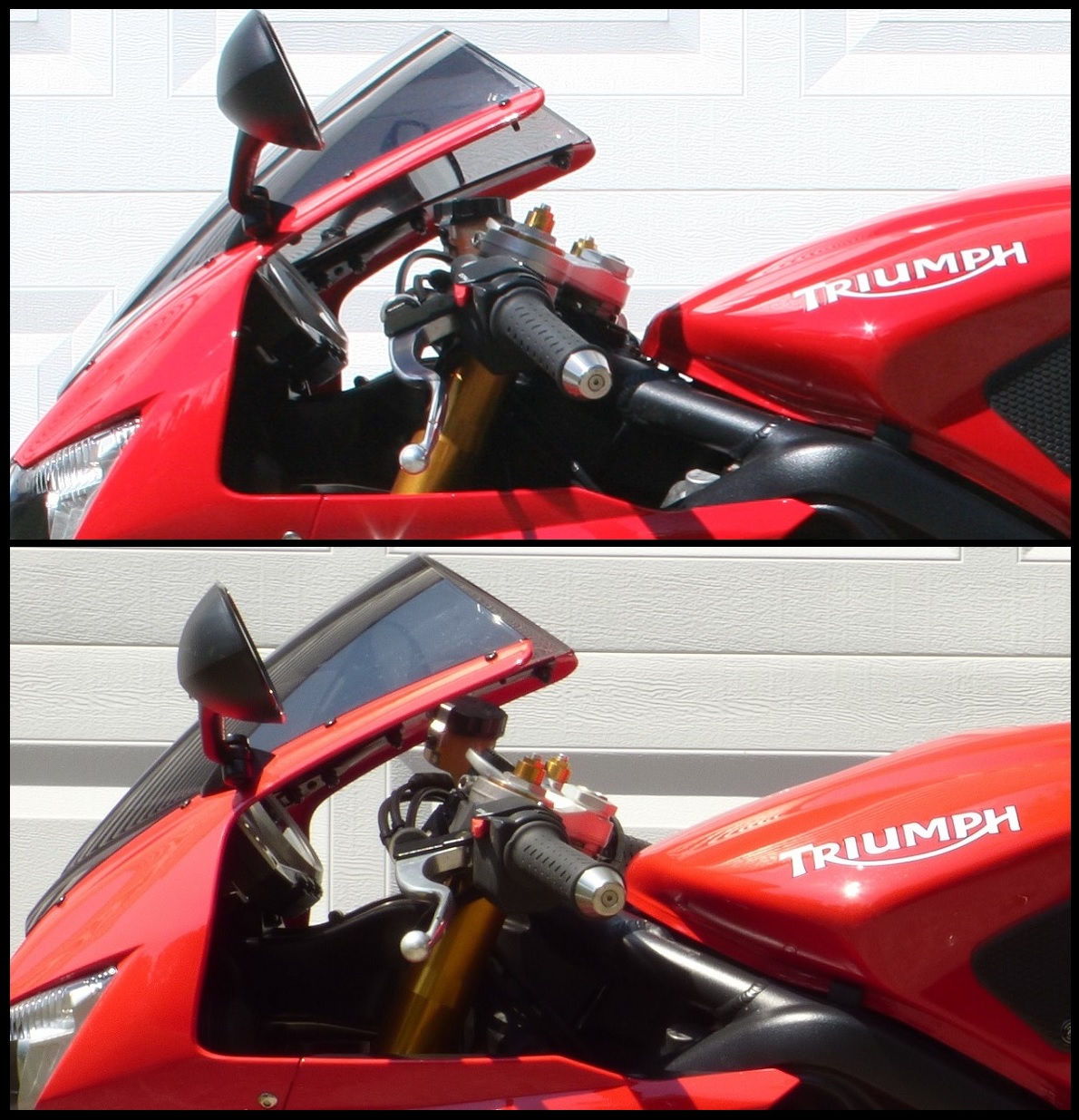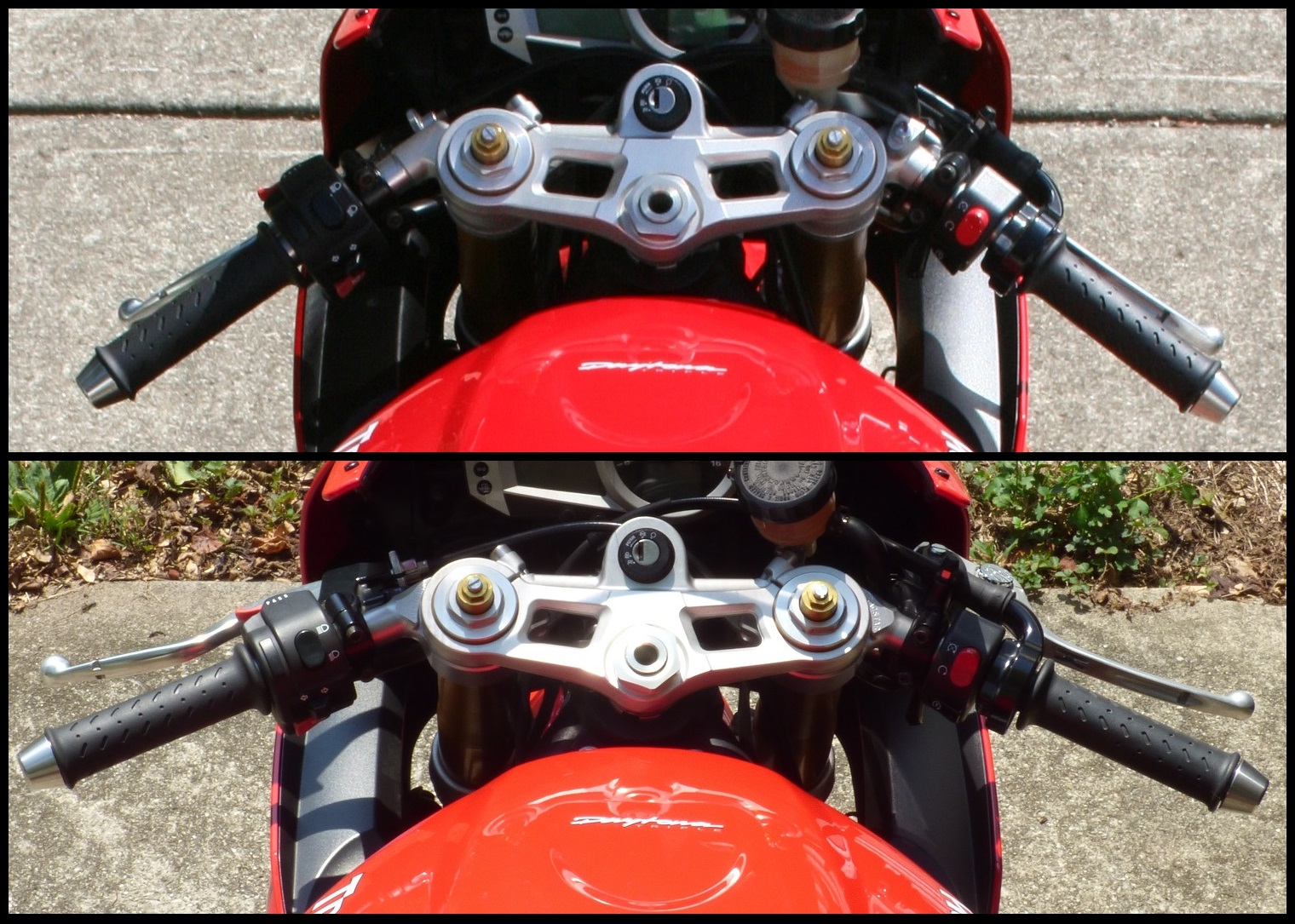Comfort was not on the priority list when Triumph was developing my 2006 Daytona 675. Performance, handling and creating a viable competitor to the Japanese competition in the 600 cc supersport class, yes. Comfort, no.
I bought my Daytona when it was just a year old and had less than 3,000 miles on it and I’ve always loved the motorcycle. I love its handling and the way the triple produces the smooth power I want while still providing the “character” and “soul” that other riders demand. But I haven’t ridden it as much as any of the other bikes I’ve had in that time. The Daytona is one of those motorcycles that feels better the faster you ride, and it’s only really at home when I take it to a track day. On street rides, there are three main things (for me) that make my old muscles tire and ache after more than a 100-mile stint in the saddle.
First of those is the saddle itself, which is very firm. It’s great for not getting in the way when you’re shifting your weight around and hanging off at the track, but if you sit on it in the same position for long, it feels like the unforgiving plank it essentially is.
Second is the underseat exhaust. The Daytona came out at the end of the underseat exhaust trend, which looks cool (in my opinion) but has the performance drawback of putting weight up high where you don’t want it and the comfort drawback of putting extreme heat where you don’t want it. Specifically, on the Daytona, my right thigh gets quite toasty in city traffic. Again, this is another reason why the faster you go the better the bike feels, because the wind carries away the heat. Sitting at a stop light? I know a hint of how Colonel Sanders’ victims felt.
The third issue is the position of the stock clip-ons. They are low, even by the standards of race-replica sport bikes. Some people will say there’s a fourth issue, in the foot peg position, but I don’t have any problem there. I always did have a problem with the clip-ons, however. My TechSpec tank grips helped me maintain proper riding position and keep the weight off my wrists, but still, after a long ride I’d end up with sore neck muscles and I’d be generally twice as tired as I would after the same ride on any of my other motorcycles. It was this problem that I set out to solve by installing a set of HeliBars on my Daytona 675.
The pros and cons of HeliBars on a Daytona 675
There are some obvious pros and cons of the HeliBars. The advantages start with the high quality (frankly, I think they look better than the stock clip-ons) and the fact that they fit perfectly and work with your stock control cables and brake lines. The disadvantages are that they make a limited difference in the riding position and they are about the most expensive option available. You pay for the quality and convenience.
In the case of the Daytona, no alternative to the stock clip-ons is going to radically transform the motorcycle into a comfortable sport-tourer. The packaging is so tight that unless you’re willing to modify the fairing and change other components to relocate the brake fluid reservoir, you’re not going to be able to make a huge difference, and few Daytona owners want to do that kind of surgery on a beautiful sport bike. At that point, buy something else.
HeliBars’ information says that on my first-generation Daytona their replacement clip-ons raise the handgrips 1.65 inches and, just as importantly, change the angle, so they are flatter. How much difference would that make? Enough to make it worthwhile to go to the expense and effort of swapping the clip-ons? I found myself riding around with my fingertips on the grips, imagining them 1.65 inches higher. It seemed promising.
I got a second opinion from the useful cycle-ergo.com web site, which allows you to plug in your height and see how you fit various bikes. It also lets you make changes from stock, and it said a 1.5-inch rise in the clip-ons would yield a riding position that was four degrees more upright. Four degrees didn’t sound like much, and with prices around $300, I had my doubts. But my wife encouraged me to think of it as a birthday present (and the more birthdays I have, the more I need HeliBars), so I took the plunge.

The top photo shows the stock clip-ons and the bottom photo shows the HeliBars. From the side, you can see that the change in height is not huge, but it does make a noticeable difference. Any further increase in handgrip height would require serious modifications to the fairing.
Installing the HeliBars on my Daytona 675
Installation took me a little more than an hour, but I’m a slow-moving amateur mechanic. The instructions were good. The slow-downs were mostly due to the tight confines of the Daytona cockpit and fiddly little things that took time to sort out. At one point, I thought I would have to remove the fairing just to access a bolt head, but I found I could just remove the infill panel to reach it.
In addition to instructions with photos, HeliBars makes it easy by having all the difficult stuff done for you. There is no “universal fit” here. The clip-ons are made specifically for your vehicle, so there were location holes for the controls and the bar ends were drilled to accept the stock bar-end weights. If you’ve ever tried to drill a control location hole in a replacement handlebar, you know what a time- and stress-saver it is to have this done for you.

The top photo shows the stock clip-ons and the bottom photo shows the HeliBars. From above, you can see the HeliBars are wider and have a different angle. They are nearly flat, while the stock clip-ons angle down and backward.
So are they worth it?
That’s what you really want to know, right? How do they work and are they worth the cash outlay? Well, they do improve the riding position, but as I knew going in, four degrees is incremental, not transformational. My Daytona is still very much a sport bike, not a sport-tourer, but the position is improved. The way I would describe it is this: With the HeliBars, the Daytona has the riding position it should have had from the factory, not the more extreme ergonomics Triumph chose. Because of that, I don’t feel they will make the bike any less fun or capable when I take it to the track.
Most people complain about weight on their wrists, but if you’re riding properly, you’re not resting your weight on the handgrips, because that causes unwanted inputs into the steering and reduces control, in addition to just plain making your wrists hurt. Of course holding your weight up by using your core muscles means you tire more, and the greater the forward lean, the greater that effort. That was the real problem for me, along with the sore neck I had after every long ride. A track day instructor once asked me why I wasn’t tucked in more tightly on the straight and I showed him the limits of how far back I could bend my neck. He seemed a little shocked. I wasn’t that flexible even when I was young, and I’m certainly not any better now, as I’m on the glide path to 60. Reducing the strain on my neck is the biggest change the HeliBars have made for me.
So the question of “Are they worth it?” really comes down to what your budget and goals are. How big a hit is $300 to you? Are you just looking to make your Daytona more enjoyable to ride or are you trying to build a sport-tourer? HeliBars will do the former, but not the latter.
In a few weeks, I plan to put them to the real test. I’ve never done a ride of much more than 250 miles in one day on the Daytona, but I’m going to take it on one of my regular trips to Philadelphia, about 475 miles one way. Since I sold my Versys and haven’t replaced it yet, now’s the time to try the trip on the Daytona. I figure breaking it down into four, two-hour stints is reasonable, without making the ride an ordeal, now that I’ve addressed the biggest comfort issue.
As for the other two comfort issues, I’ll be putting my Airhawk pad on the seat and, to keep the thigh-roasting heat under control, I’ll just have to keep up my air speed. Sounds doable.
